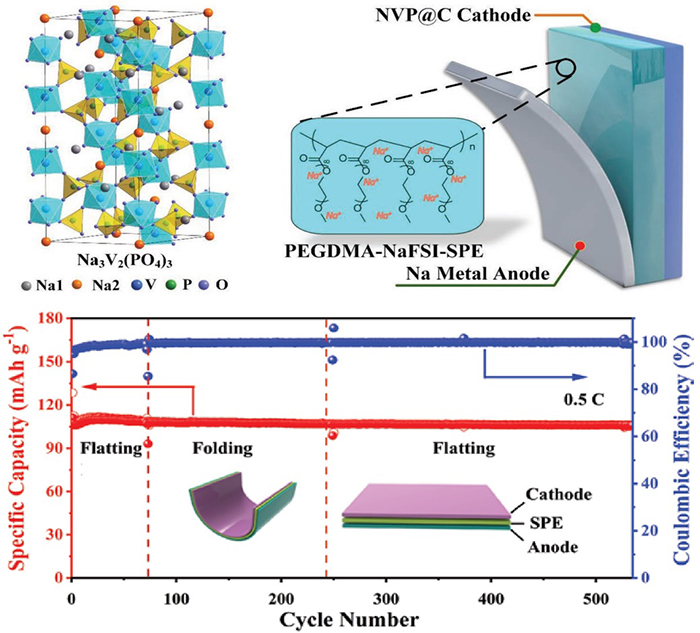Researchers led by Prof. WU Zhong-Shuai from the Dalian Institute of Chemical Physics (DICP) of the Chinese Academy of Sciences (CAS), in collaboration with Prof. YU Yan from University of Science and Technology of China and Prof. Yao Yinxia from Ningbo Institute of Materials Technology & Engineering of CAS, recently developed high energy density all solid-state sodium ion batteries with excellent flexibility by building an integrated system of solvent free solid polymer electrolyte and cathode material. The batteriescan effectively strengthen the solid-solid interface contract, reduce the interface impedance, and significantly improve the transfer efficiency of electrons, ions and charges. Their results were published on Advanced Energy Materials.

Schematic diagram of flexible all solid-state sodium ion batteries and the corresponding cycling stability. (Image by HOU Xiaocheng)
Sodium ion batteries are considered as ideal devices for large-scale energy storage due to its abundant sodium resources and low cost. Traditional sodium ion batteries mostly used liquid organic electrolytes, which are prone to leakage and combustion. Using solid sodium ion electrolytes instead of flammable organic liquid electrolytes can greatly improve battery safety.
However, the development of all solid-state sodium ion batteries are facing the great challenges: (1) the low ionic conductivity of the solid-state electrolyte; (2) the poor interface compatibility between the solid-state electrolyte and the electrode materials; and (3) the large volume change of the electrode materials during the intercalation and de-intercalation of sodium ions.
All of these problems lead to the large internal resistance, low capacity and short lifespan of the solid sodium batteries. Therefore, it is urgently needed to develop more efficient solutions to overcome these issues and satisfy the needs of commercial applications.
The scientists developed a novel solid-state polymer electrolyte (PEGDMA-NaFSI-SPE) by utilizing in situ solvent-free UV-cured method firstly, which has a high ionic conductivity (up to 10-4 S/cm at the room temperature) and excellent flexibility. Then sodium vanadium phosphate modified by a thin layer of carbon (5 nm) cathode materials (Na3V2(PO4)3, NVP@C) with improved electron, ion and charge transfer efficiency were synthesized by sol-gel method.
Based on the previous work, scientists built an polymer electrolyte/electrode material integrated system for high-performance all solid-state sodium battery (NVP@C?PEGDMA-NaFSI-SPE?Na) using carbon coated NVP@C composite nanosheets as the cathode, solvent free solid polymer PEGDMA-NaFSI-SPE as the electrolyte and metallic sodium as the anode, which effectively strengthened the solid-solid interface contact, reduced the battery interface impedance, and realized a flexible solid-state sodium battery with high specific energy and long life. The battery can be stably cycled 740 times at a rate of 0.5 C, and the capacity decay rate is only 0.007% for each time.
Meanwhile, the capacity retention rate was still as high as 95% even after 3 months resting, indicative of low self-discharge rate of the all solid-state sodium battery. What is more, the soft-packed sodium battery can still provide an energy density of up to 355 Wh/kg after 535 cycles under the flat and bent states. The design strategy of this work provides a new direction for the development and application of flexible and high energy density all solid-state sodium batteries.
This work was supported by such as National Natural Science Foundation of China, National Key R&D Program of China, Dalian National Laboratory for Clean Energy of CAS. (Text by HOU Xiaocheng)